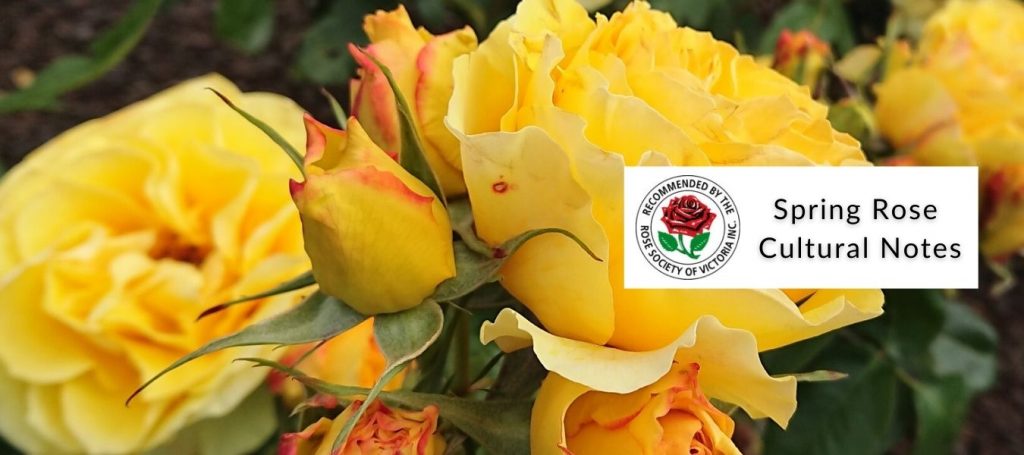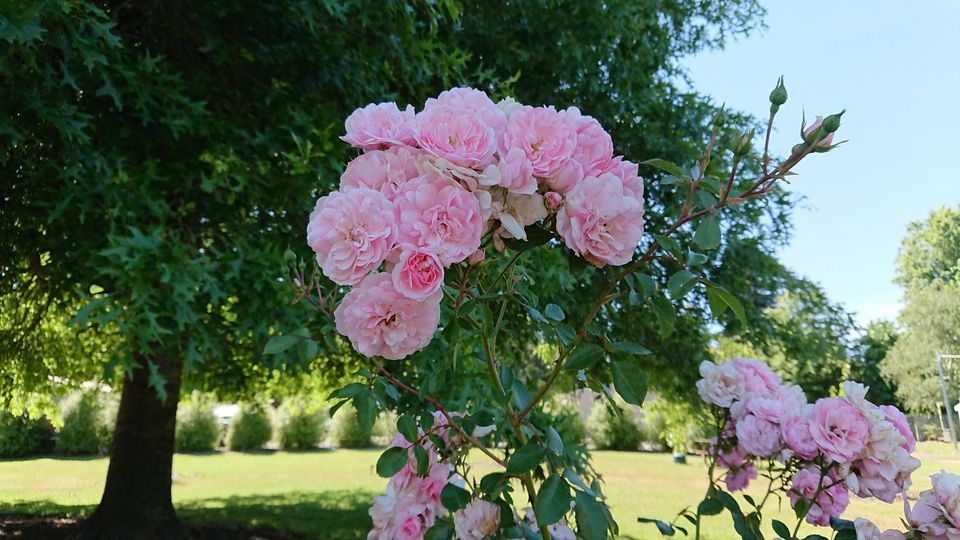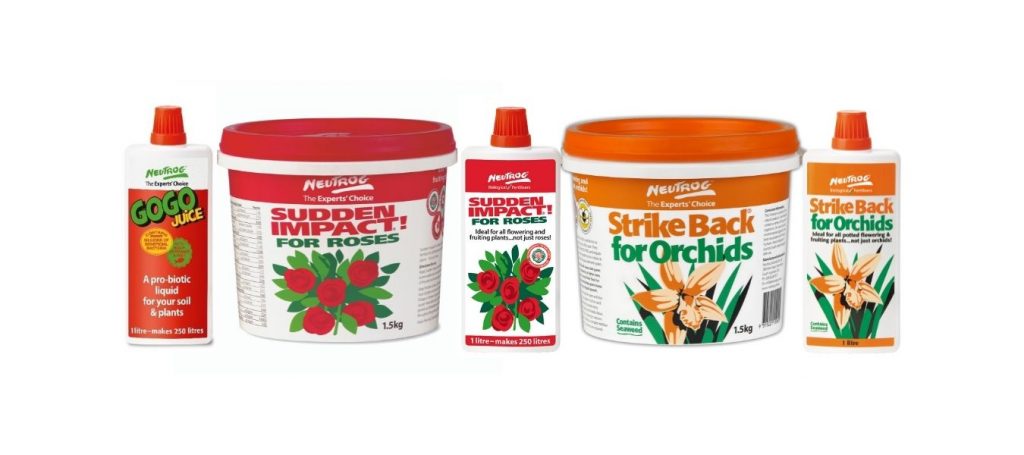
SPRING ROSE CULTURE NOTES FOR VICTORIA
Rose Society of Victoria, written by Dr. Jacinta Burke
[Header Image by Michelle Endersby]
The most beautiful time for roses has arrived. After a cold Winter, the warm Spring days have brought on a flourish of growth and the promise of many beautiful blooms. Now is the time to enjoy the fruits of your winter labours. Your rose bushes and climbers should be showing strong growth.
Spring Maintenance
There are many tasks and problems that need to be dealt with at this time of the year.

Photo by Michelle Endersby
Pests
Aphids rear their ugly heads in the Spring. They multiply rapidly to suck the sap out of new growth. If not contended with they will distort new leaves and flowers. There are a number of strategies that can be employed to reduce the harmful effects of these pests. If the aphids are only present in small numbers, they can be squashed using your fingers. Alternatively, you can use a jet of water to dislodge them from the plant. If present in large numbers, the most efficient method is to spray using an environmentally friendly chemical. Pyrethrum is a knockdown spray so needs to actually get on the aphids to have its effect. Pyrethrum is safe to animals in its diluted form but is harmful in its concentrated form. Pyrethrum is non-specific so it will kill beneficial insects as well as aphids. Eco Oil will suffocate the aphids if sprayed on them. It is even more effective if combined with Neem Oil.
Caterpillars can also damage foliage and flowers. In my experience they are usually only present in small numbers and can easily be squashed. However, if present in large numbers, use pyrethrum or Eco Neem.
As October and November approach roses can be inundated with thrips. These unwelcome pests can quickly distort and damage flowers. Typically, they prefer to infest pale-coloured flowers particularly white ones. They are very difficult to control because so many of them are blown in by the wind. While sprays like pyrethrum will kill the thrips present at the time of spraying, new thrips will arrive the next day. The only option is daily spraying of the flowers.
Hot, dry weather will see the appearance of two-spotted mites. These pests initially congregate on the backs of the lower leaves of the plant. They can be seen as tiny eight-legged mites with two red spots on their back. They are less than a pin head in size and need a magnifying glass to see properly. As numbers build up, they produce a fine webbing and move about on this webbing and the leaf surface. They suck the sap out of the leaf, which takes on a speckled sandy appearance before eventually falling off. A bad infestation can quickly defoliate a plant. As soon as these pests appear spray the entire plant, especially the backs of the lower leaves, with Eco Oil. This will suffocate the mites. Repeat the thorough spraying the following week to kill any mites that may have hatched. It is probably expedient to spray a third week as these pests are very resilient.
Fungal Diseases
There are two fungal diseases that can be prevalent in the spring months. Black Spot will start to appear on the older foliage. By the time symptoms appear it is too late to spray this foliage as the disease has already entered the tissues of the leaf. When it comes to Black Spot the best course of action is to take a preventative approach. The aim of the exercise is to prevent the fungus from entering the leaves in the first place. In the past, sprays that are harmful to the environment have been used. In Europe these sprays have been banned and no doubt it is only a matter of time before Australia follows suit. We can however use harmless, environmentally friendly sprays. Eco Rose and Eco Fungicide are based on using potassium bicarbonate to change the pH of the surface of the leaf. By making the surface alkaline this prevents the spores of the fungus from germinating. To be effective against the fungus it must be sprayed over the entire surface of the leaves, including the undersides, every 7 – 10 days.
The other fungus that can be troublesome at this time of the year is Powdery Mildew. This typically attacks the new growth. Powdery Mildew is most active in conditions of hot or warm days with cool nights. Early symptoms of Powdery Mildew can include red blister-like areas on the upper leaf surface, followed by a white, powdery growth on the aerial parts of the plant. Preventative spraying with Eco Rose or Eco Fungicide is the best approach to dealing with the problem.
Fertilising
If you haven’t done so already, your established roses can be fed at the end of Winter or beginning of Spring. Both established roses and new roses planted in Winter can also be fertilised in the second half of November. Fertilisers can be applied on top of the mulch and left to be watered in by rain, or if you prefer, they can be hand watered in. It is best to spread fertilisers evenly over the ground. Sudden Impact for Roses is recommended and watering in well with GOGO Juice will ensure that you have a diverse range of beneficial bacteria and fungi added to your soil. Organic fertilisers gradually acidify the soil and can lead to the inhibition of nutrient uptake. It is a good idea to apply a light dressing of lime at New Year to correct this, and to replenish the large amounts of calcium taken up by the roses for their spring growth.
Foliar Feeding
Roses can be given an extra boost to growth by liquid foliar feeding. Virtually any liquid fertiliser can be used as a liquid feed. Liquid fertilisers like Sudden Impact for Roses and Strike Back for Orchids can be used in their diluted form and sprayed onto the foliage. Liquid fertilisers have a minimal effect on the soil. Do not spray if the temperature is forecast to be more than 25°C.
 Watering
Watering
A time-saving and economical method for watering roses is to have in-line drippers under mulch. Check the moistness of the soil under the mulch before watering established roses. Roses planted last Winter need more frequent watering during their first Spring and Summer. New roses need consistent moisture in the soil in order to establish their delicate root systems. Failure to maintain this is often the cause of poor results later. It will be next winter before the roots harden off. If allowed to dry out over the Spring and Summer months they will die back with the result that subsequent top growth will be stunted. Watering should start in September and be done twice a week, unless the garden receives heavy rain. Light or brief showers don’t count as they do not penetrate deep into the soil. Always give your new roses a good soak before hot days.
Mulching
To maintain even moisture in the soil it is essential to spread mulch over the surface. There are many mulches from which to choose. Many gardeners are worried about the aesthetic appeal of the mulch, which must set off their garden design. Wood chips are a commonly used mulch and while appealing and retaining moisture they can remove nitrogen from the soil as they break down. It is always good to add some nitrogenous fertiliser such as Meatworks – Blood & Bone to the soil to overcome this problem. Some people use pea straw. This is very good for the soil as it adds nitrogen to the soil. Unfortunately, some batches of pea straw are riddled with pea seeds. These all germinate after watering and create a nuisance as they must be pulled out so that they do not compete with the roses for moisture. A relatively new product on the market is Whoflungdung. This product adds nutrients to the soil for both the beneficial bacteria and plants to feed on. It is aesthetically pleasing to look at and apparently blackbirds do not like it.
 Propagation
Propagation
Those cuttings taken in June should be starting to produce shoots by October. While it may appear that a cutting has struck, this is not always the case. Roots can be slow to develop from the callus. An application of liquid Seamungus will be beneficial to your cuttings and assist in encouraging a strong root system. Cuttings can be potted up in December, until that time do not feed the cuttings. Any cuttings that have not produced roots can be put back into the propagating mix and kept moist for a further six weeks. In February these slow developers can be potted up.
Contact the Rose Society of Victoria – website https://rosesocietyvic.org.au for more information.

